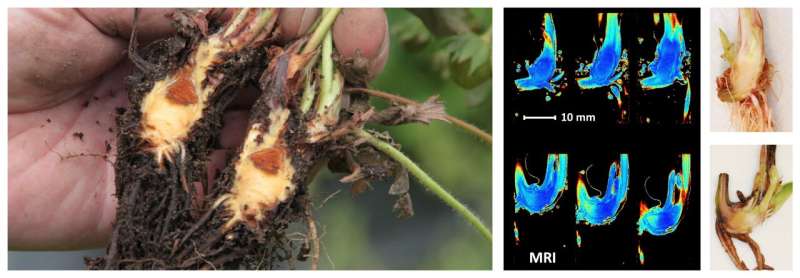This article has been reviewed according to Science X's editorial process and policies. Editors have highlighted the following attributes while ensuring the content's credibility:
fact-checked
trusted source
proofread
MRI shows how crown rot infection progresses in strawberries

Researchers from the Department of Technical Physics and the Department of Environmental and Biological Sciences at the University of Eastern Finland have used magnetic resonance imaging (MRI) to investigate how the pathogen Phytophthora cactorum affects the growth and development of strawberry plants. This pathogen causes crown rot in strawberries and can lead to significant losses on horticultural crops.
The researchers used MRI to investigate differences between healthy and infected plants over a three-week period, discovering that infected plants differ significantly from the healthy ones. Published in Scientific Reports, the study found that infected plants had elevated relaxation times inside their crowns compared to healthy ones.
These differences were observed both as spatial and temporal changes, which made it possible to visualize infection progression. MRI data were also confirmed with the anatomical structure of the plants by dissecting their crowns at the end of the experiment. In infected plants, the presence of the pathogen in the crown was easily visible even to the naked eye.
MRI is routinely used in the hospital setting; however, applying it to relatively unconventional sample materials, such as plants, opens up new possibilities. MRI is a particularly sensitive method for detecting water, and this is why the researchers expected it to be well-suited for investigating internal damage in plants. With MRI, it is possible to obtain data on, e.g., the distribution and quantity of water within a sample.
The study employed various quantitative magnetic resonance imaging methods to investigate infection-induced changes in strawberry crowns. These quantitative values give an indirect indication of the integrity of plant cell structures, allowing for comparison between infected and healthy plants without damaging them. This enables long-term monitoring and assessment of disease progression.
The study suggests that MRI could be used for monitoring the health and development of plants, for investigating the progression of plant diseases, and for related research. MRI could also help to understand mechanisms of interaction between plants and pathogens, and to develop new strategies for preventing and combating plant diseases.
More information: Teemu Valtteri Tuomainen et al, Non-invasive assessment and visualization of Phytophthora cactorum infection in strawberry crowns using quantitative magnetic resonance imaging, Scientific Reports (2024). DOI: 10.1038/s41598-024-52520-7
Provided by University of Eastern Finland





















